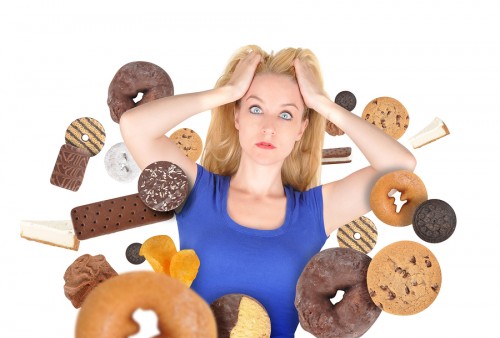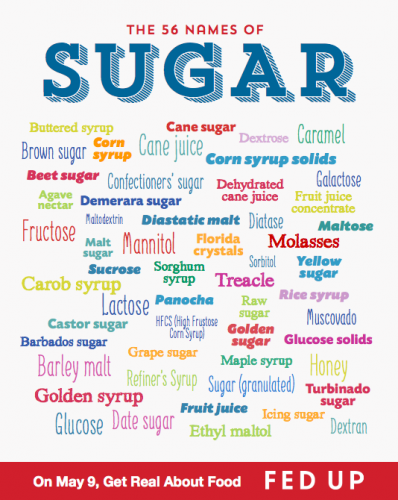The 10-day no sugar challenge! Will you join me?
 A couple of weeks ago my friend Gary posted on Facebook that he was going to do 30 days of yoga and no sugar and asked who would join him.
A couple of weeks ago my friend Gary posted on Facebook that he was going to do 30 days of yoga and no sugar and asked who would join him.
I was the only taker! And neither Gary nor I had even watched the documentary “Fed Up” yet.
“Fed Up” proposes a 10-day no sugar challenge. If you go to the website www.fedupmovie.com you can sign up to join the challenge and get helpful reminder emails for 10 days.
You can watch the “Fed Up” trailer at the end of this post.
I am now on day 11 and feeling great. But I’m surprised no one else wanted to join us so I thought a blog post on why we should be avoiding sugar was in order.
Because sugar is slowly killing us as a nation.
The Fat Fallacy
In the mid-1970s, a misconception swept the U.S that the fat in dairy and meat made us fat, birthing the “non-fat,” “fat-free,” and “reduced fat” movement.
Food was engineered to reduce or eliminate the fat, which made it taste terrible, so sugar was added to make the food palatable.
Scientists have since learned that it’s the added sugar that makes us fat, not the natural fat found in food.
The 30+ years that Americans have been eating non-fat, sugar-pumped foods have given rise to an unparalleled obesity epidemic.
In the history of mistakes, replacing relatively harmless fat with harmful sugar was a pretty big one!
Shocking sugar facts
ONE. 80% of processed foods in the U.S. contain sugar – and sugar is highly addictive which means we will just buy more of it.
80% of the U.S. food supply is also genetically modified, but that’s a post for another day.
The average American today eats 30 times more sugar in a year than the average American did 100 years ago!!! Thirty — that’s not a typo. 150 pounds of sugar today versus 5 pounds a year in 1900.
TWO: Take a look at the Nutrition Facts Panel on the back of anything in your pantry or refrigerator. It lists the quantity of fat, cholesterol, sodium, fiber, sugars and protein. On the right hand side is the % of the recommended daily value [100% is the amount we are encouraged to consume in a day].
Did you ever notice that there is no percentage after the sugar content? Neither did I.
The sugar industry claims there is no % RDV because the government hasn’t set one. We have sugar industry lobbyists to thank for that.
In fact, much of our food, in one serving, far surpasses the daily amount recommended by the American Heart Association.
We’ve been lulled into complacency by the food industry to accept whatever’s on the Nutrition Facts label, even if it contains a glaring omission and hides the fact that we’re eating way more sugar than is good for us.
THREE: The food industry has steadily been increasing the amount of sugar in the food marketed to children such as cereals, fast food and soda. The result is the first generation of children expected to have a shorter lifespan than their parents.
One school teacher interviewed in “Fed Up” said she used to have 1 child in 10 who was obese, but today that number is 8 out of 10!
Childhood obesity rates have doubled in the last 30 years, since sugar started being added to our food supply.
The average American consumes 22 teaspoons [88 grams] of sugar a day – almost four times what the World Health Organization says is a healthy amount.
According to the American Heart Association, women should have no more than 6 teaspoons [24 grams] per day and men no more than 9 teaspoons [36 grams].
The average child consumes 32 teaspoons [128 grams] a day!
The American Heart Association recommends 4-8 year olds have 3 teaspoons [12 grams] of sugar a day and preteens about 6 teaspoons [24 grams]. A serving of Fruit Loops cereal contains 12 grams of sugar.
One candy bar can contain more sugar than you should eat in a day.
Carbonated soft drinks are the largest source of refined sugar in the American diet: 40 grams in an average 12-ounce soda can.
Have you read the sugar content in your “organic” energy bars? Shocking, which is why I gave them up a year ago.
The average American consumes 3.2 cups of sugar a week, which is the equivalent of 27 candy bars.
FOUR: The future. The consumption of sugar is growing faster than the world population.
It’s predicted that within 20 years, 95% of Americans will be overweight or obese.
That in turn leads to a concern that in another generation we will have a shortage of military, police and other first responders because they won’t be able to pass the physical due to the obesity epidemic!
FIVE: Refined sugar is linked to a host of diseases such as:
- heart disease,
- high blood pressure,
- hypoglycemia,
- diabetes,
- depression,
- acne,
- headaches,
- depression,
- hardening of the arteries,
- fatigue,
- hyperactivity and
- tooth decay.
Type 2 diabetes has increased three-fold in the past 30 years, coinciding with the increase in sugary food products.
SIX: Sugar is as addictive as cocaine; it releases an opiate-like substance that activates the brain’s reward system. Brain scans after sugar consumption are similar to those after someone has taken cocaine or heroine.
SEVEN: Refined sugar has no nutritional value. It contains no vitamins, minerals, enzymes, fats or fiber. Everything beneficial is removed during the refining process.
According to Robert Lustig M.D., author of “Sugar: The Bitter Truth,”
“We’re biologically programmed to like sweets—our tongues and brains know that no food on the planet is both sweet and poisonous. It was a test for our hunting-and-gathering ancestors: If a food is sweet, it won’t kill you. It’s ironic because that’s exactly what sugar is doing to us now.”
You’ll get more information about the hidden bad things in healthy snacks in this excellent article from kitchencabinetkings.com: “What popular Healthy Snacks are made of.”
Tips for reducing sugar intake
The Fed Up Challenge is to go sugar-free for ten days.
I know that eliminating sugar entirely when we’re addicted to it, and it’s in everything, is hard. But even just limiting sugar intake to the American Heart Association guidelines will be a big step in the right direction.
I haven’t had too hard a time with it because, as a vegan, my diet was already pretty clean.
But I’ve noticed that as I detox from sugar, even the Stevia [see below] I put in my tea is starting to taste too sweet to me! Interesting.
Also, I’m no longer craving the dark chocolate I used to have after every meal. [yes, every meal].
And I’ve lost three pounds in the past 11 days!
Read food labels and aim to buy products with less sugar. Just because a product doesn’t list “sugar” in the ingredients doesn’t mean it isn’t there. Almost all processed food contains added sugar.
Here are the other names for it:
Shop on the outer aisles of the supermarket. That’s where the produce, meat and dairy are found. The inner aisles contain processed, sugar-added foods.
Eat whole fruit instead of fruit juices, which are high in natural sugar.
Avoid sweetened drinks such as soda, lemonade, iced tea “power drinks” which are like liquid candy! The only thing I drink every day is water. I’ve even given up beer and wine during the challenge.
If you need sweetener, use Stevia from the health food store in your coffee and tea -– that’s what I use. [other artificial sweeteners are toxic].
The leaves of the stevia plant have been used for centuries by native peoples to sweeten foods, with no evidence of harm. It’s also been used safely in Japan for over 30 years. You can also grow the stevia plant at home.
This Halloween, have a jar of nickels by your front door and give nickels out instead of candy. Do you really want to encourage childhood obesity by giving out candy?
Re-think your breakfast cereal and energy bars. That energy boost you’re getting is just from the sugar.
Eliminate one thing at a time. If you drink 3 sodas a day, cut down to two.
Don’t have cookies and candies in the house. As a chocola-holic, that’s my solution. If it’s not in the house, I can’t eat it. Save yourself for special occasions out.
But the most important thing is to just try to cut back on junk food and sodas. Read labels, eat out less, cook good meals at home. You’ve heard it all before.
But maybe now it’s clearer than ever that the standard American diet [SAD] is killing us. It’s called SAD for a reason!
If you try the challenge, I’d love to hear how it goes for you. Good luck!
Sources for this post:
http://www.mindbodygreen.com/0-4543/14-MindBlowing-Facts-About-Sugar-Infographic.html
http://www.salon.com/2014/08/25/9_shocking_facts_you_need_to_know_about_sugar_partner/
http://www.framingham.edu/food-and-nutrition/documents/sugar-facts.pdf
Molly Larkin is the co-author of the international best-seller “The Wind Is My Mother; The Life and Teachings of a Native American Shaman” and other books on health. She is passionate about helping people live life to their fullest potential through her classes, healing practice and blog at www.MollyLarkin.com


